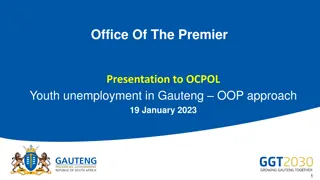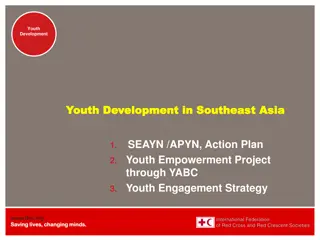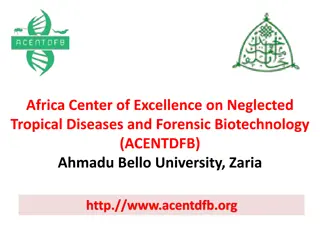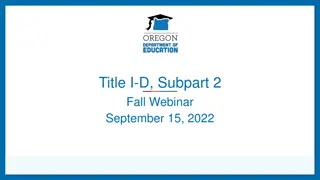Enhancing Educational Services for Neglected and Delinquent Youth
This document explores Title I-D, Subpart 2, focusing on improving educational services for neglected, delinquent, and at-risk youth in locally operated facilities. The Oregon Department of Education collaborates with various partners to ensure equitable access to quality education for over 580,000 K-12 students. The purpose, eligibility criteria, funding aspects, and allowable uses of funds under Title I-D are discussed, emphasizing the goal of enhancing transitions into the community and preventing dropouts. Additionally, details regarding fund transferability and requirements to prepare students for post-secondary pathways are presented.
- Educational services
- Neglected youth
- Delinquent youth
- Equity in education
- Oregon Department of Education
Download Presentation

Please find below an Image/Link to download the presentation.
The content on the website is provided AS IS for your information and personal use only. It may not be sold, licensed, or shared on other websites without obtaining consent from the author. Download presentation by click this link. If you encounter any issues during the download, it is possible that the publisher has removed the file from their server.
E N D
Presentation Transcript
Title I-D, Subpart 2: Basics Neglected, Delinquent & At-Risk Youth
Oregon Department of Education Our Why Equity and Excellence for Every Learner The Oregon Department of Education works in partnership with school districts, education service districts and community partners; Together, we serve over 580,000 K-12 students; We believe every student should have access to a high-quality, well-rounded learning experience; We work to achieve the Governor s vision that every Oregon student graduates with a plan for their future. Oregon Department of Education 2
Outcomes for Today Overview of Title I, Part D basics including: Eligibility and Funding Application requirements Allowable use of funds Resources Oregon Department of Education
The purpose of Title I-D, Subpart 2 is to improve educational services for students in locally operated facilities for neglected or delinquent students to: Provide opportunity to meet state standards Purpose of Title I-D, Subpart 2 Improve transitions into community Prevent drop out and return to facilities Oregon Department of Education
Eligibility: An LEA is eligible to receive funds if there is a locally operated facility within its geographical boundaries Eligibility and Funding Funding: Determined by annual October Caseload Count Neglected funds flow through Title I-A Funds can be used at facility, district, and school levels Oregon Department of Education
Transferability Funds can be transferred into Title I-D Can transfer all or a portion of the funds into a grant award for the same year Must be claimed from original award in EGMS Carryover funds cannot be transferred ESSA Quick Reference Brief: Transferability Oregon Department of Education
Requirements Prepare students to complete high school, enter training or employment programs, or further education Facilitate transition Dropout prevention programs Allowable Uses of Title I-D, Subpart 2 Suggestions Serve at-risk youth Coordinate health and social services Mentoring & peer mediation CTE, special education, career counseling Oregon Department of Education
JULY 2022 AUG 2022 NOV 2022 2022-23 FEDERAL FUNDS TIMELINE 2022-23 BUDGET NARRATIVES DUE 2022-23 BUDGET NARRATIVE APPLICATION OPENS BEGINNING OF 2022-23 GRANT PERIOD NOV 2023 SEPT 2023 FINAL DATE FOR ALL 2022-23 CLAIMS FOR *INITIAL GRANT PERIOD FINAL DATE FOR OBLIGATION OF 2022-23 FUNDS FOR *INTIAL GRANT PERIOD NOV 2023 UNCLAIMED FUNDS BECOME CARRYOVER NOV 2023 NOV 2024 SEPT 2024 CARRYOVER APPLICATIONS FOR 2022-23 FUNDS OPEN FINAL DATE FOR OBLIGATION OF 2022- 23 FUNDS FINAL DATE FOR ALL 2022-23 GRANT CLAIMS *INITIAL GRANT PERIOD: 7/1/22 9/30/23 (15 MONTHS)
Supplement Not Supplant Title I-D cannot be used to supplant, or take the place of, state or local funds that would have been spent if federal funds were not available Test I: Are the services that the district wants to fund with ESEA funds required under state, local, or another federal law? If they are, there could be the presumption of supplanting. Test II: Were state or local funds used in the last year to pay for these services? If they were, there could be a presumption of supplanting. ESSA Quick Reference Brief: Supplement Not Supplant Oregon Department of Education
Application Requirements Completed in CIP Budget Narrative Answer all questions Describe and budget for any costs associated with the program Oregon Department of Education
Oregon Department of Education Title I-D Oregon Department of Education Youth Corrections Juvenile Detention Education Programs Oregon Department of Education Long Term Care and Treatment Education Programs USED: Title I-D: Neglected , Delinquent, and At-Risk Youth Non-regulatory Guidance National Technical Assistance Center for the Education of Neglected or Delinquent Children and Youth (NDTAC) National Center for Juvenile Justice Resources Oregon Department of Education 11
Please reach out! Jen Engberg jennifer.engberg@ode.oregon.gov Oregon Department of Education 12
Questions? Oregon Department of Education 13























